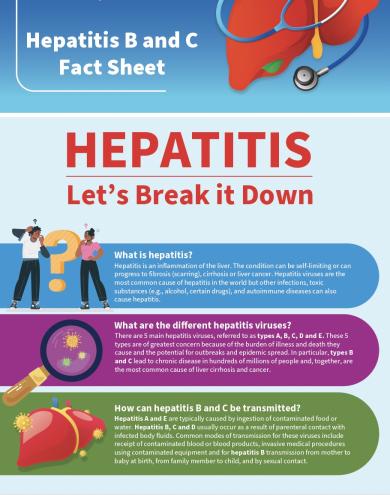Dying from viral hepatitis in Africa is becoming a bigger threat than dying from HIV/AIDS, malaria or tuberculosis. Yet, a new analysis shows that the disease remains neglected in many parts of the continent.
The epidemic of viral hepatitis B and C affects 325 million people globally and is 10 times larger than the global HIV epidemic. Every day, more than 3600 people die of viral hepatitis-related liver disease, liver failure and liver cancer.
In Africa, chronic viral hepatitis affects over 70 million Africans (60 million with hepatitis B and 10 million with hepatitis C). Hepatitis B infection is preventable, treatable and hepatitis C virus infection (HCV) is now curable. Yet, despite the availability of diagnostic tools and effective treatment, over 90% of people living with hepatitis B and C in Africa lack much needed care. The result is at least 200 000 deaths a year in Africa, often among the continent’s most youthful and productive population. Fewer than 1 in 10 people in Africa have access to testing and treatment, so the disease often progresses to advanced liver disease with its associated catastrophic financial burden as well as emotional distress and stigmatization.
With adequate resources and strong political commitment, this disease can be eliminated by 2030.
Hepatitis B
The hepatitis B virus is transmitted through parenteral and percutaneous contact with the blood or other body fluids of an infected person.
In highly endemic areas, hepatitis B is most commonly spread from mother to child at birth (perinatal transmission), or through horizontal transmission (exposure to infected blood), especially from an infected child to an uninfected child during the first 5 years of life. The development of chronic infection is very common in infants infected from their mothers or before the age of 5 years.
Transmission of the virus may also occur through the reuse of contaminated or poorly sterilized needles and syringes either in health-care settings or among persons who inject drugs. In addition, infection can occur during medical, surgical and dental procedures, through tattooing, or through the use of razors and similar objects that are contaminated with infected blood.
Sexual transmission of hepatitis B may occur, particularly in unvaccinated men who have sex with men and heterosexual persons with multiple sex partners or through contact with sex workers.
The hepatitis B virus can survive outside the body for at least seven days. During this time, the virus can still cause infection if it enters the body of a person who is not protected by the vaccine. The incubation period of the hepatitis B virus is 75 days on average, but it can vary from 30 to 180 days.
Initial exposure to hepatitis B virus often results in acute infection in all populations. However, the development of chronic persistent infection depends on age. Infection in infancy leads to chronic hepatitis in about 95% of cases and 40 to 60% in early childhood infections. In contrast, less than 5% of infections acquired in adulthood result in chronic infections.
Hepatitis C
The hepatitis C virus is a bloodborne virus and WHO estimates that in 2015, there were 1.75 million new HCV infections in the world (23.7 new HCV infections per 100 000 people). The most common modes of infection are through parenteral exposure to blood, blood products and other body fluids.
- In Africa, the reuse or inadequate sterilization of medical equipment especially syringes and needles in health-care settings and the transfusion of unscreened blood and blood products (especially in people with sickle cell disease who receive multiple blood transfusions) are the commonest routes of transmission.
- Sexual practices such as having multiple sexual partners and men who have sex with men are important routes of transmission especially in immunosuppressed populations like people living with HIV.
- Intravenous drug use is recognized as the most prominent route of transmission in Europe and the USA and has become an emerging concern for hepatitis C transmission in Africa.
- HCV can be passed from an infected mother to her baby; however, these modes of transmission are less common except in pregnant women who are also injecting drug users.
Hepatitis C, like hepatitis B is not spread through breast milk, food, water or casual contact such as hugging, kissing and sharing food or drinks with an infected person.
It is not possible, on clinical grounds, to differentiate viral hepatitis from hepatitis caused by other viral agents; hence, laboratory confirmation of the diagnosis is essential. A number of blood tests are available to diagnose and monitor people with hepatitis B or C. They can be used to distinguish between acute and chronic infections. WHO recommends that all blood donations be tested for hepatitis B, hepatitis C and HIV to ensure blood safety and avoid accidental transmission to people who receive blood products.
Hepatitis B
Laboratory diagnosis of hepatitis B infection focuses on the detection of the various hepatitis B antigens (hepatitis B surface antigen, HBsAg and hepatitis B e antigen, HBeAg) and antibodies (mainly antibodies to HBcAg). The presence of HBsAg identifies current infection (either acute or chronic).
- Acute HBV infection is characterized by the presence of HBsAg and immunoglobulin M (IgM) antibody to the core antigen, HBcAg. During the initial phase of infection, patients are also seropositive for HBeAg. HBeAg is usually a marker of high levels of replication of the virus. The presence of HBeAg indicates that the blood and body fluids of the infected individual are highly infectious.
- Chronic infection is characterized by the persistence of HBsAg for at least 6 months (with or without concurrent HBeAg). Persistence of HBsAg is the principal marker of risk for developing chronic liver disease and liver cancer (hepatocellular carcinoma) later in life.
- Hepatitis B DNA testing is required to evaluate disease stage and may be required for treatment and monitoring decisions.
Hepatitis C
In the absence of a serologically developed HCV antigen test, HCV infection is diagnosed by identification of HCV antibody (anti-HCV) developed by the body in response to HCV infection. This serological test identifies all persons who have been exposed to HCV infection and is unable to distinguish current infections from resolved infection.
In all persons who test positive for anti-HCV antibodies, a nucleic acid test for HCV ribonucleic acid (RNA) is needed to confirm chronic infection because about 30% of people infected with HCV spontaneously clear the infection by a strong immune response without the need for treatment. Although no longer infected, they will still test positive for anti-HCV antibodies.
Acute infections
All patients with acute hepatitis B and C require evaluation for disease severity and may require hospitalization. Clinical care is aimed at maintaining comfort and adequate nutritional balance, including replacement of fluids lost from vomiting and diarrhoea. Most important is the avoidance of unnecessary medications. Acetaminophen/Paracetamol and medication against vomiting should not be given. There is no specific treatment for acute hepatitis B. However, acute hepatitis C may require specific antiviral therapy.
All persons with chronic HBV or HCV require further assessment for the degree of liver damage (fibrosis and cirrhosis) and require biochemical testing, imaging and fibrosis assessment through a variety of non-invasive tests or liver biopsy. The degree of liver damage is used to guide management of the disease.
Hepatitis B
Chronic hepatitis B infection can be treated with medicines, including oral antiviral agents. Treatment can slow the progression of cirrhosis, reduce incidence of liver cancer and improve long term survival. Only a proportion (estimates vary from 10% to 40% depending on setting and eligibility criteria) of people with chronic hepatitis B infection will require treatment.
WHO recommends the use of oral treatments – tenofovir or entecavir – as the most potent drugs to suppress hepatitis B virus. They rarely lead to drug resistance compared with other drugs, are simple to take (1 pill a day), and have few side effects, so require only limited monitoring.
Tenofovir is no longer protected by a patent anywhere in the world and multiple generic formulations exit. Additionally, it is a common drug component of HIV therapy and is widely available within HIV programmes in Africa. Paradoxically, it is often inaccessible and unaffordable to patients with HBV mono infections. The median price of WHO-prequalified generic tenofovir on the international market fell from US$ 208 per year to US$ 32 per year in 2016.
Entecavir is now also off-patent. In 2017, all low- and middle-income countries could legally procure generic entecavir, but the costs and availability varied widely.
Treatment is very effective and can cause long-term viral suppression. As in HIV infection, treatment is often lifelong. The need for long-term follow-up, adherence and counselling, shared diagnostic platforms and overlapping treatment requirements are important reasons for strategic collaboration to foster cross-programmatic efficiencies.
There is still limited access to diagnosis and treatment of hepatitis B in many resource-constrained settings. In 2016, of the 257 million people living with HBV infection, 10.5% (27 million) were aware of their infection. Of those diagnosed, the global treatment coverage is 16.7% (4.5 million). Many people are diagnosed only when they already have advanced liver disease.
Among the long-term complications of HBV infections, cirrhosis and hepatocellular carcinoma cause a large disease burden. Liver cancer progresses rapidly, and since treatment options are limited, the outcome is generally poor. In low-income settings, most people with liver cancer die within months of diagnosis. In high-income countries, surgery and chemotherapy can prolong life for up to a few years. Liver transplantation is sometimes used in people with cirrhosis in high-income countries, with varying success.
Hepatitis C
A new infection with HCV does not always require treatment, as the immune response in some people will clear the infection. However, when HCV infection becomes chronic, treatment is necessary. The goal of hepatitis C treatment is to cure the infection.
WHO’s updated 2018 guidelines recommend therapy with pan-genotypic direct-acting antivirals (DAAs). DAAs can cure most persons with HCV infection, and treatment duration is short (usually 12 to 24 weeks), depending on the absence or presence of cirrhosis.
WHO recommends treating all persons with chronic HCV infection over the age of 12 years. Pan-genotypic DAAs remain expensive in many high- and upper-middle-income countries. However, prices have dropped dramatically in many countries (primarily low-income and lower middle-income countries), due to the introduction of generic versions of these medicines.
Access to HCV treatment is improving but remains too limited. In 2017, of the 71 million persons living with HCV infection globally, an estimated 19% (13.1 million) knew their diagnosis, and of those diagnosed with chronic HCV infection, around 5 million persons had been treated with DAAs by the end of 2017. Much more needs to be done for the world to achieve the 80% HCV treatment target by 2030.








